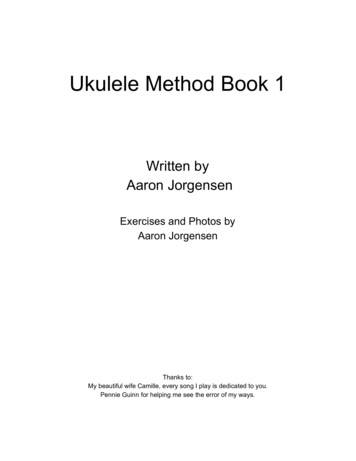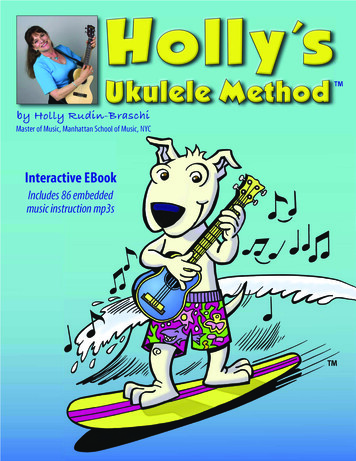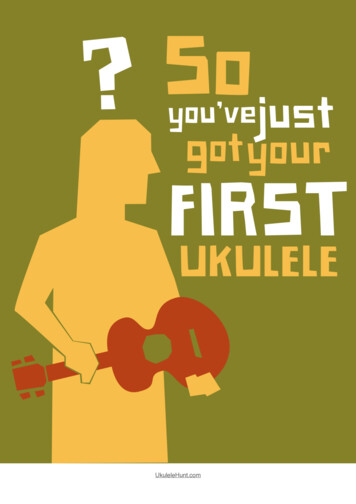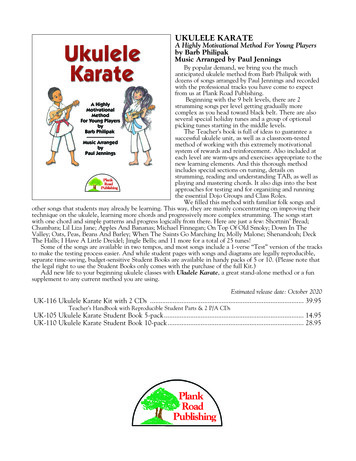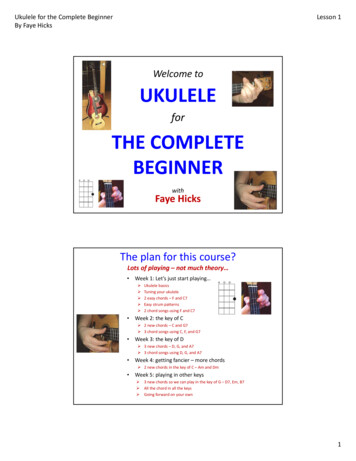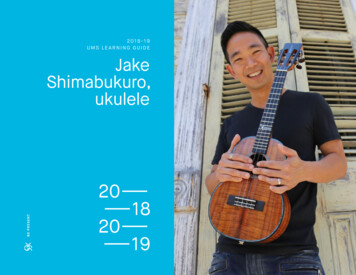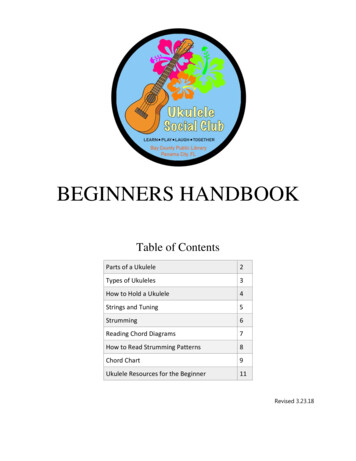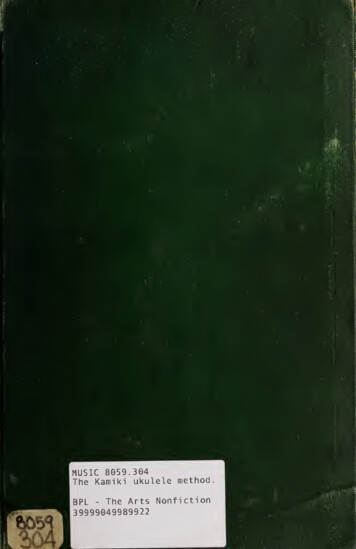
Transcription
mmmmmmwasWmKW8mMafia ISnuSSg j !MUSIC 8059.304The Kamiki ukulele method.The Arts Nonfiction39999049989922BPL-
rE""3i \9 &L JB L t
-N JKamtkiiiUkdeleMethodMiWininunintmnuuiiUUill%.« AMVi-E*U:J*.«5V«ftti,'. \\«y*iVt*5*'w;j.smith music co* * .tni hminnnnwwwiui]&mu
Pe,Nu "Pickor\StrumWithin thisArea.\ jund Hole orStringtSSridgiPose
KAMIKI o«].3o fUKULELE METHODshowing the Correct PositionFor Holding the UkuleleCopyright MCMXVUby W? J. Smith & Co. New YorkIllustration
The riUkuleleJ pNuti# FretNeckand.FingerboardJick or StrumWitimfe AreaSoundorMeRosetteString?'ridge
TheUkulele -BanjoTbsiHon.Mark?Fingerboard/\
Rudiments of MusicMusical notation is composed of various signs and characters. The firstto be noticed is the staff, consisting of five parallel lines and the spaces between them. On the lines and in the spaces, characters called notes are writ1ten to represent the sounds.THE STAFF AND NOTES5thLin e-4th Lin e-*»4lot4th Space3rd Space"iaLinone-fte-GE2nd space1st SpaceDBFEImmediately below and above the staff are the following two notes, D andmg.GDHigher and lower pitches, or sounds, than the above, are represented byshort lines called leger or added lines, written above or below the staff.LEGER LINES AND NOTESm 'ABDCFECBAGEThe notes are named after the first seven letters of the alphabet and areemployed over and over again; and when written in regular succession,withthe first note repeated- after the seventh, a scale of eight notes will be formed;thus: A, B, C, D, E,F,G, A.beginning of a scale; as:Any oneC,of the first seven lettersD,E,F, G,A,B,C.may be the firstorTREBLE CLEFbeginning of compositions for this instrument.It establishes the note G, on the second lineof the staff and from it, all other notes are determined; either ascending ordescending, as in the following example.[The TrebleClef,made thus(5), isalways placedat theF?itjftJDrcr*-e-GF*EB JrrG
RUDIMENTS OF MUSICnecessary that the student should he acquainted with the duration ofIt ismusical notation.The relative value of the notesshown byis bestthe following arrangement:Notes are divided into Bars by single or double lines drawn across thestave.One line —placed after each bar. Each bar contains the same num-isber or value of notes, and must last precisely the same length of time.Seven characters determine the value of notes, seven the value ofrests.FORMS OF DIFFERENT NOTES AND RESTSWhole note Half note Quarter note Eighth note 16 note 3 2 note 64 note43CEI#J .J,Jl*WholeA Dotr;(forest Half rest Quarter rest Eighth restplaced after any note increases-,,E isequal to('\Tits T*15 rest 32 n d rest ,-—5fto fforECOMPARATIVE TABLEshowing the Relative Value of Notes1Whole Note-*&-equals2 Half Notesj.J-equals4 Quarter NotesJequals8 Eighth NotesequalsNotesand so on.16 SixteenthU.xxnJ.l6ithrestvalue one half, Thus:r—-.oriF ,iito f
How441stringto tune the Ukulele.3 rJ* string"O2 nA stringifD11* string -XEBFffThe open strings can be tuned to the piano by following the above diagram. Another method is to time the D stringDD string at the4th fret, tune the F# string in unison; next, stop the Fjf stringtomiddleon the piano, then, stopping theat the 3t? fretand tune thesame system, stop theBA stringin unison; following thestring at the 5*- fret and tune theFjfstring in unison.Thestringmust be stoppedHowright behind the frets noton them.to string the Ukulele.For the First String use Banjo 3 r d stringFor the Second String use Violin E stringFor the Third String use Violin A stringFor the Fourth String use Banjo 3rd stringTo holdThethe Ukulele.arm should be thrown well forward, holding theUkulele between the thumb and joint of the forefinger, thetip of the thumb resting on the side next to the A string nearleftthe first fret, with the first finger on the side of theThe middleBof the right forearm should press thestring.backof the Ukulele to the body, holding it firmly so that it maybe played either standing or sitting. In order to get the besttones from the instrument, great pains should be taken to holditexactly in the manner described above.FOR TIPLE, TAROPATCH(Ukulele style)andTENOR-BANJOTUNING, Seelastpage
mScales for the Ukulelestring4tl 3Ld string!l"and stringiiFrets2BA23i3EFGAD MAJOR1st string#pf68FG1S-rt2-ABPRINCIPAL SCALE3rd stringi112nd stringllft "ist stringFretsDiagraml s tNotes on thefe P 1210n12Notes on the 2nd string:#*t Notes on the 3 r.d string]! :v21Notes on the34 stringP0*12A orNotes played on thein reading43&4th string are written an octave lower to avoid confusionChromatic Scale3rd stringJujJJFrets 9.12nd s t r i n"ItfC majorIJJI*stringmffI 1n m 0t0 2Signatures andA minorJ Jl s tgNamesG majorE minor2of the Principal436AD maj orB minorFt*majorminormajoruF maj orD minorE maj orEl G# minorG minorC minorii*#Copyright1'MCMXVII by W 7g J.89101112Major and Minor Keys*FB major5«fr»rfTSmith& Co. New YorkEmajormC# minorAt maj orF minorate
11Notes onNotes on theEAA or 4th StringString sound one octave higher than written4jj JJJJ Uiii 'jjjg' rtJi jj JjUijj U flF'"i»iJ JJ2-Jait J:J'JJ'(J:J'Notes on EoJrfmv/3ZZt)u»DJi*ii' J 'J: iJ:or 3rd String—& T&UW- ii isim flm. "*i*i'11c AA U* X) 3 SiTJM3a"*V3fl*}Amv11111U*UCJNotes on F# or 2nd StringS5 2i« 8"SfNotes on#EH T if«y opI3 Ht# 322 -trmw*ssipIt*fra re "J*B 3»l9*Jm4mrJ.2T22or 1st String3 PT3P r*fap 1«38p*rl rfQp i
12SCALE AND EXERCISES IN KEY OF C4thWStringy3rdW String m023Frets 3Notes C2nd\lString#-[9*(i4 iJ Jl3» .j'Jt i 3*opJ FPIn:5t§:31BCDEirt! l3rdStringy320Count threeJ-t*PrfWfGA#pgjti2ndString013 531013DEF1stStringP1 r PPm #gk(-* S - r ri-,JJrli id i-
31''578753310104thString3rd2m3Vrm-6 -aHawaiian BoyKAMIKIU 1&23fe B iffj TTCount1&23PrTnrna0*n# i:nWV3nnII4 J:FtnnnVn4 J J**-r J J J J 'IFIFIF*o» 5 5 5 s'» * * * rrrrjiir s § r-h*'u Jmig3poJnnV §rj a:toInViS m
—*,»14gnd str.3rd st r.iA*I1W" LlStr.*i 4th1 SJ Str.32iff3 2Waikalulu m*JW.jJ jjimr*— —iS*f#"itjJiJj«—rid . »*iJ*KAMIKIJ. J —g .g -jr fi,J»i.-i ;—* *#i *fc* ECopyrightMCMXVIbyW!?J.Smith &Co.New Yorki111
15How To Read The DiagramsThis Pageisfor explanatory purposes andThe four verticalisnotmeantfor practicelines represent the strings of the Ukulele, and the horizontallines represent the first five frets of the finger-board.The string on the righterwhen instrumentisistermed thefirst,andis theone furthest fromthe play-held in position for playing.ExampleN92ExampleN91oOONut.1l?tF re t,4P" 2n d Fret.3Ld?Fret.4th Fret.5th Fret.4th 3rd2 l tSTRINGSThe black dot indicates where the stringbe stopped, and the numbersindicate the fingers of the left hand. When a string is to be played open (without being touched with fingers of the left hand) the sign is thus O.In illustration (number 1) the fourth string is stopped at the 2 n d fret.usingthe2ld finger. The 3 r d string is played open, the 2".d string is stopped at t hell1 frecusing the 1«* finger, and the 1 SJ string is played open. Always place the fingers beis tohind the frets, not on them.1 " " Illustration (number 2) shows the barrein which one finger stops orpresses two or more strings.Example: The first, second and third strings are stopped by the first finger,at the first fret.The fourth stringisstopped by the third finger at the thirdfret.Study this pag-e carefully beforetrying" the next
16ChordsiD majorilll1:*5ooDoGo ]\A 7thooO(,D, 3lo4 23o »o3sit4*BChords ink minorltIB moinE minG4thB minO91 23 4*4'Modulations in Key ofi -—OwDoqDO OB7thoGGmin„D„A7th„ Q51 f442l»4 r
Chords in G major\7* QDMjoth7'o-1toG19494O149492294949349EChords inminor*UEA— minminorE min-o11o2th7'o oBLJia11O4292?4449Modulations in Key of G**iW* aGGo7th124*4t*22o94499Ooii1i tGC min9 oDo7 t]ioi/49492299
—18Chords in C major1GAo7lhi1oJLo4 22**23* 43O O 2o3Oi A minorChords in%A9 minorE7D min,A mint h1r4 249494 24o43OModulations in Key#TfC7*32o3CIiiFFminC11/oofiif4o G7tholcTT/4H tr* 4 22o29424 tj t*i t—,3
u& 19Chords in A majoroE7tho-L o2oiti 9it4umFjtChords inminorFffmB minoro o -ominoriCft7 th-oFjtminorI2tti t22it4t99t&itModulations in KeyU—y-mAA7thofA——DDminorAjV 2o4ootoA21 it1oO2i*9O94O9it
20iUPChords inEmajor11AoBE7th Oi*X3/ooo2o o oitChords in C# minorU.i3ICtfminminorGj7thCflminp/84*4Modulations in Key offrfa;,l j!L*IEE11 LJLJLO7jhAJs.minF11OnBOE7th,L2
21Chords inFmajorI3tFC7thBt 11f422882 8itChords inDminorf%D minorA 7 G minD mint2i1it i3i t1ititi2i8it9it81i4tM
22Chords in Bhk?B\ E\ j* t*FB7thiLZj' LJ[jL20XO OI22 23o9InOl OI3Chords in G minor——mwGminC minimin1it91i *f\GD7thOOPi422t3O1i «3 » 'V4t4i91
23Chords inE\ majorii3EbBb7t]iAbEb149 I'22 Li33f** t(22 4»33Chords in C minor5' W3mmG 7*hFminC minr1142 »(.7424PI-34»4 43 'CopyrightMCMXVI by W?J. Smith & Co., NewYork4 l»4
24Chords innk*vyA\ majortDbAbEb7*} 11 1IPj» 122 *9233jP3Chords inF minormm*Fmin.C7thBbmin.Fmin.1l #224»3i2 J»432 3Copyright43»4f J»4MCMXVI by W? J. Smith S;Co.,New York
25DIMINISHED SEVENTH CHORDSand their InversionsA/ lJ Seri esIfJPDionA Din ?'I A'.tmmBDimA Dim—nInversions/svAt DimB Dim—1? 4* i'44P21**ti21 44»«43f4» J.21*43It14P O34AUGMENTED FIFTH CHORDSDb iieitiD3,b*El 4i1i)iTjSF ? 22(LJt4,?4f2434F2Ely a,,G4Gb3teaii;WIFt*t?17*(L th *AHaii P *W;A2i »4»Bl.*IS.ais4»J'1it 41The above diagrams show Twelve Augmented 5th Chords; Practically thereare only four, and for this reason we have marked above each chord, its name rinda number- You will notice that all chords of a same number, although writtendifferently, are played exactly alike.
26/TRANSPOSING CHARTFor the benefit of those who haven't the time nor the inclinati on to seriously study transposition, we have devised the following chart, wherebyanyone acquainted with the chords of the Ukulele, can easily learn tochange from one key to another.Major1 liChords in C- »m »D»Minor2"d 3rd \/4thFG7th AD! G! At 7thDG Ac7thDmin E7th C 7thBtmin Etmin F7th DWthB min E min F#7th D7thC min F min G7th E!»7thCkn Ft* min Ghth E7thD min Gmin A 7th F7thmin.»E\ -E! A\ Bl 7th} »EB»FEFA ) »GtGl Ct D 7th Etmin At min "GGcD7th E min A »» At-At Dl Et 7th))„A "Bk »B-7thBt C 7thFitminAD EB\ Et F 7th GminBEF**7thAllied Chords9th8th6in / 7th5thF min7th G#minBl 7thD7thA 7thAugmented 5 th10th11th \No. 1 Dim CAug-El 7th Bl 7th No.E 7th B7thF7th C 7th2DimDbAug.No. 3 »D Aug."El Aug.No.lF#7th Cl»7th No. 2» EG7th D7thNo. 3»FAug.Gt7th A! 7th El 7th No.l-GkAug.»GB7th G7th A 7thBtmin C7th At 7th BWthB min Ctt7th A 7th B7thC min D7th B! 7th C7thC#min D**7th B7th C*7thminE7th No. 2F 7thAug.Aug.No. 3 »At Aug.F#7th No.l"A Aug.G7th No. 2»BtAug.G#7th No. 3"B Aug.column of the chart, is the name of a Key Chord,and all other chords,- reading horizontally from it, are the attendant harmonies or chords belonging to that key, or, closely connected with it. The1st, 2nd and 3rd columns, show the chords in major-, the 4th, 5th and 6thcolumns, their minor connections; the 7th, 8th, 9th, 10th and 11th columns,are chords that are allied to them, either through the major,or theirminor relations.Eachletter in the firstHOW TO USE THE CHARTIf we have an accompaniment in the key of C, commencing with thechord of C, and wish to transpose the same to the key of D, we find underthe given chord of C, the chord D, which must be taken in its place,andsoon through the entire piece, always finding the corresponding chord ofthe new key directly under or above the chord to be transposed.Showing Chords transposed from C to D, thenChords in C. original KeyThe above transposed to DThe above transposed to E\?Amin Dmin E? thBmin Emin F thEb Cmin Fmin G hG7th c.D. G. A?th DC. F.Eb AbB thto Eb
27While the following songs and accompanimentsisread music,it isso arranged as to be of e-qual value to thosebywhointended primarily for thosewho performentirelyear.Thisner:ismade possibleEach chordcompaniments,isasitin the following man-appears in these ac-not only writtenitsinmusical notation, but also labeled withnameor title C, G, D, orchordmayitswhatever thebe.Needless tosay, thetune or air in thesepieces, though written for the voice,maybe carried by Violin, Mandolin, or any leading instrument.
p28One, Two, Three, Four.BY REDDING,arr.byW ? J.Smith.1m *Hi 13 3mzzmJ J:#DP«-*-2—theI 1 1 3 1:D A7th D MH# Mby-m-A7thDD wherestreaml t?g-Gfr;i DownP :ff DGF#7thr 1 I lE* * -*T«a«aI#««1 * 1 1 * J 1 J *A7thA7thRemetfirstA7th fS-# m * J 1 * 1fl4A7thbee— —n* —Fl rM iD-
29 * p:Thesun loves StoshinesJ »l J S lwww wW-WWE7thE7tht&::-0--0--0-J- :the:-W-7D S- W-W-W-A7thA7thZZJ huedgar-Brightlands woveIRefor-4I FIF F*D*ftP Jz t J iJA7thA7th5ZJ%jdi #-0-0-0-W&—«.WW-DW wW was1 3 1» » wWm B7thgazedinto-i « j i i ta j jw A7thi4Emin.« -itheyHeyesherB7'thTV wereBrightca,DPA7thA7thhec.11j j 1 1 tjW3EE mineifjeifh i;DDA7th§iChorus.4One,two,three,ww w2four,Some timesi« »-#-Dwww- WWwG*wIf
,30*Fj T tzz: wish there werezwei,*f -«-** t*gft m-w-S-S-D idrei&;,,#3 « * * « : \ZL WS-0-0-0SGD*WW WGSp *n,*?fIvier.Ionethelovethat'snear.#-*- *m «l«S« S5 5555J: 55 ***** e,w wwwwtht:ttDF#7th. Lx-rJiirheath- en chi j nrrget-j «FSjfrlf iP?hOne,left, www4-VDB7th-ww-rtherereft,GDD-4beFair girlsnee,- rMJ JUir*IiwillSo sayssee,* ***E7thtwoand three, y A7thw w-w-w--#DD
31MyBonniei 3 1.2.3.PMyBonnien: :15i --i--low,Lastcean,Andnieliesnight asIblow, ye winds,mp»MyBon-nieP ? io-verliesto- cean,thelay on myLast nig-ht asIOh, blow, ye winds, o-ver thepil- low,o-cean,Oh,IAnd Mi,UliSJr-H— TltTilTFTGaati* f Go-i'sea;bed;sea;.5:pilBonJ JiJJ J JJ41 EEfflf***3 13*e o - ver thelay on myo - ver the-iMyo- cean,ver thelay on myo - ver theoliesnight asIblow, ye winds,LastOh,mi- 17 t.h7*1»CFCHORUSI3bringdreamtbringf—t-?- backthatbackmymymyI 1 sT 1I bringBon - nie toBon - nie wasBon -nie toback,back,back,1 1i i fetrrrittG7* im-prrrBring back my Bon- niej»GFj»ij»7*h
mmm wasm m m Wm MafiaW8mK ISnuSS g j ! MUSIC8059.304 TheKamikiukulelemethod. BPL-TheArtsNonfiction 39999049989922
